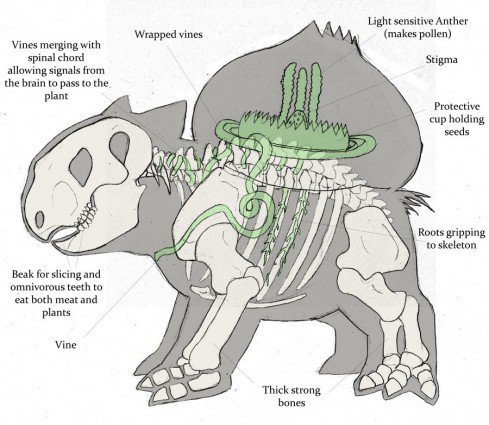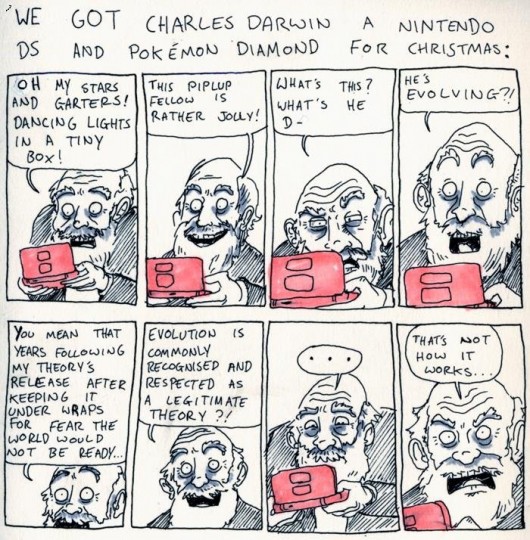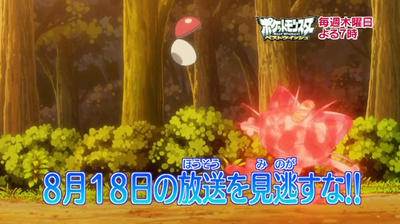Hello there! Welcome to the world of Pokémon! My name is Jen! People call me the Pokémon Grad Student!
…Okay, I don’t think anyone has actually called me the Pokémon Grad Student. But I’m a PhD candidate studying evolution and genomics who has been playing Pokémon since its release in 1998. My friend showed me his Red version, and soon after I owned my first video game – Pokémon Blue. I’ve been hooked since then.
As I progressed through my training as a biologist, I started to look at the Pokémon world in a new light. At first, it was irritation. Everything seemed wrong. They confused metamorphosis for evolution. Breeding didn’t make any sense – different Pokémon species could interbreed, but the offspring were always the same species as mom. Gender ratios didn’t reflect biological mechanisms, but rather a game designer’s attempt to keep certain Pokémon rare. Why, it was if they were trying to design a fun game with no regard to biological accuracy
darwin heart piplup by claudetc
But as I learned more biology, I started to realize nature isn’t as simple as it seems. There are all sorts of strange biological phenomena that result in counter-intuitive mechanisms, traits, and organisms. Nature is really, really weird. So I started viewing the Pokémon world as a puzzle. If I were Professor Oak, what experiments would I be doing? Are there any natural processes in the real world that could explain Pokémon biology?

Bulbasaur Anatomical Study by JoshuaDunlop
Some of you must be thinking, “Jen, it’s just a game. It’s not supposed to make sense. Chill.” I know, I know. I don’t expect all games to be 100% scientifically accurate at the expense of fun. But I like daydreaming about how the biology of Pokémon could “work.” It’s as if I’ve discovered a whole planet of alien life to study, and what biologist wouldn’t want that?
But more importantly, I see the Pokémon world as a great way to teach people about actual biology. And I’m hardly the first person to think this – the creator of Pokémon originally conceived of the game as a way to share his childhood hobby of collecting insects with the children of a modern, urbanized Japan. But I’ll be discussing what I know best: evolution and genomics. How do Pokémon species differ from species here on Earth? What does genomic imprinting have to do with breeding? Can an organism like Eevee actually exist? I’ll be exploring these topics in future PokéBiology 101 posts.
Now, there are some things in the Pokémon Universe that are above my pay grade. I’m not even going to attempt to explain how a tiny mouse generates thunderstorms or how some Pokémon have psychic abilities. I have no clue how a Pokéball can transform Pokémon into pure energy and back again (maybe a bored Physics grad student can hazard a guess). And there’s certainly no explanation for how Onix, a ground/rock type, suddenly becomes vulnerable to electric attacks because a sprinkler system came on (yes, I am still bitter about that episode).
I have no idea how this works.
For all of those things, I’m willing to suspend disbelief. But when it comes to the biology of the Pokémon world, I’ve found it’s not necessary to invoke “magic!” as an explanation. Because oddly enough, that bizarre biology is already happening here on earth.
Welcome to PokéBiology 101!
Next in series: “Evolution” and the enigma of Eevee




This should be good. If I had to guess, I’d say that Pokemon “evolution” is an extreme, accelerated version of puberty, with a backup guess of “extreme, accelerated version of metamorphosis”.
I only ever played Generation 1. I quit when I caught Mewtwo (no, not Mew… Mewtwo) a lorded it over my friends for about a month…. so yes, Mewtwo was the top when I played. I haven’t played since.
I’ve been back-and-forth about getting back into the video game, because it was actually fun, but I haven’t played since… again… Generation 1, so I’d feel really behind.
But this is a series I’m definitely going to have fun reading. The parts about whether any of them could actually exist in reality will be, I think, the most fascinating posts. Those are what I’m looking forward to the most.
*bored physics ex-grad-student*
It’s not that it’s hard to explain how pokeballs would work. What’s hard is explaining why a society with that kind of technology would only use it to capture pokemon.
By the easiest explanation, Pokeballs would have to contain a staggeringly powerful supercomputer, a matter-assembler (idk, nanites? high precision/high speed forcefields?) and a long-range electron microscope. They would disassemble the pokemon, scanning the position of each atom as they go, and store the pattern electronically. Then, later, the pokeball could reassemble the pokemon from this blueprint on command.
But then you have to explain things like, why can’t you copy pokemon? How does a pokemon break free of a pokeball? For that matter, why don’t people just skip the pokemon-fighting part and disassemble the more odious half of whatever they want destroyed? Why isn’t this same technology used for, say, a public transportation system for humans? If you can buy a matter assembler for five bucks at the pokemart, why does anyone in this society even need money?
I’ve yet to come up with a coherent account of pokeballs that avoids the above problems without turning it into either the Matrix or a fantasy setting.
Fantastic! I’m really looking forward to reading the rest of this series. :)
The blue cartridge was my first one, too, and Bulbasaur was my first pokémon. This series should be good.
Robert B
It is pretty obviously a post-apocalyptic setting. They are manufacturing the pokeballs without actually understanding how they work or why. I mean, education in their world appears to end at the age of ten (at which point kids are sent out into the world to either become champions or feed the local wildlife) and water is priced at about the same level as pokeballs.
Sure you have the professors and scientists, but it is pretty clear that they are the descendants of a far more advanced society that was likely destroyed by the appearance of the first pokemon, and are just starting to rebuild the knowledge of a past era.
Transforming a pokemon into pure energy would have… unfortunate consequences. Onix has a mass of 210 kg, which is equivalent to around 4500 megatonnes of TNT. According to wikipedia, this is around the same as the entire nuclear arsenal of the world. If that can be contained in a pokeball, I’d be very impressed. Groudon (the heaviest pokemon, according to Bulbapedia, at 950 kg) comes out at 4 times the Earth’s arsenal. So, I’d say Robert B’s suggestion makes more sense than converting things to pure energy.
@Brucegorton
You came so close. You were absolutely correct on the postapocolyptic setting, but were off on the reason. It wasn’t the appearance of the first pokemon that destroyed their society (although there’s nothing saying pokemon couldn’t have played a role), but a catastrophic war. The evidence is all over the first game. Almost every adult male you see is either a gym leader, a gang member or very old. The age of adulthood (as you rightly pointed out with your remark regarding schooling) has been drastically lowered. Hell, Lieutenant Surge talks about how “pokemon saved [his] life during the war” (not to mention the fact that he’s, y’know, a lieutenant).
The main character has no father, and his rival appears to have been raised by his sister and/or grandfather. The enforcement of laws is left to 10 year old children (Who got TM 28 back from the rocket grunt who stole it? Who diffused the hostage situation at Silph Tower? Who shut down the crime ring hidden behind the facade of the game corner?). All of this points to a drastic shortage of able-bodied adult males, which points strongly, alongside the other clues, to a large-scale military conflict.
~R~
@Robert B:
You can copy Pokémon. You just have to turn of the world while you’re saving your progress, whatever that entails.
Heh — awesome. I have two Pokemon players in my house — maybe I’ll finally get it if I keep reading!
Or not. Sigh. The teen’s already an admin on some online Pokemon site. My children have passed me in comprehension…
Maybe Pokemon are from another dimension, and the pokeballs each contain a portal to and from that dimension, rather than being the storage device you would assume?
Or is it definitely stated that they are in the balls….it’s been a long while since I saw/played any pokemon.
Sounds like a fun blog series, anyway!
This could be a topic for a book. I really like it. Maybe I can take a few of your posts and show them to my nephew. He loves Pokemon, and his parents really like creationism. Maybe this way, I can sneak some real biology to him.
This may be of interest:
“A Phylogeny and Evolutionary History of the Pokémon.” by Matan Shelomi, Andrew Richards, Ivana Li, Yukinari Okido” in improbable research (http://www.improbable.com/airchives/paperair/volume18/v18i4/v18i4.html)
Here a link to the phylogenetic tree (http://i.imgur.com/e8eFs.jpg)
A thought occurs, how long before we have teach the controversy of Poke-Creationism?
Goddamned Texas.
@Jen the Pokémon Grad Student
Ooh, ooh, I can actually help you there.
You see, the sprinkler system mimicked the the effects of the move Soak, temporarily changing Onix’s type to Water and making him quite vulnerable to Electric type attacks.
It’s not even the first time the show hinted at things to come in later generations – the very first episode featured a cameo by Ho-oh. So it’s completely legit.
Wouldn’t getting the rock good and wet allow the current to travel inside of the rock to react energetically with the rock’s minerals, turning the water to steam? At the very least, the rock would feel bloated. That was my first thought, anyhow.
I’ve often thought about the “science” behind a lot of fiction as well. My favorite is to think of how a planet that really did have vampires and werewolves would function ecologically so that both would maintain stable populations.
I always felt I was being foolish and a bit geeky with that. I may still be, but it feels good that I’m not alone.
@ scott hoyt, brucegordon:
Hmmm. And a war with that kind of technology would be intensely scary, too. I can believe that a lot of applications would be strictly taboo after the war, in addition to whatever was forgotten. (Though it seems they’re not above copy-pasting humans who have skills vital to society, like police officers and pokemon nurses. :-p Or maybe that was done during the war, to free manpower up for the front lines?)
Applying my knowledge of comic books to Pokemon leads me to believe that there may be radiation involved, maybe even Gamma Rays!!!!!! Or hazardous waste of some sort, which would also be radioactive. So radiation and more of a mutation type event than an evolutionary one. ;-)
That wasn’t a cameo – that was an artist’s screwup. It was originally meant to be Moltres.
They created an entirely new legendary bird to justify an animation error in the first episode.
(I love Pokemon.)